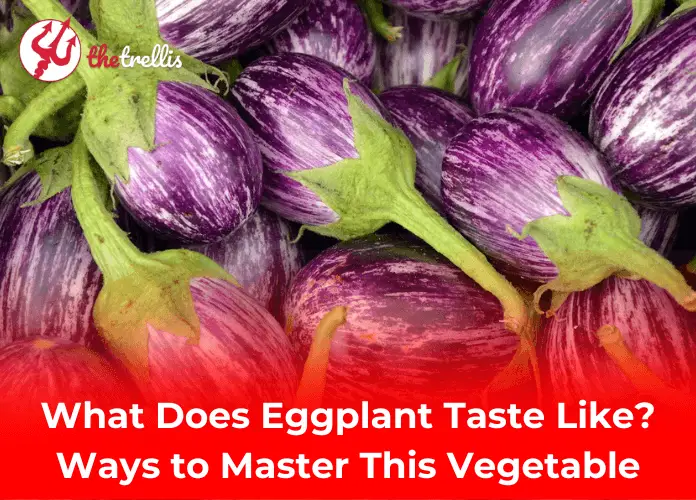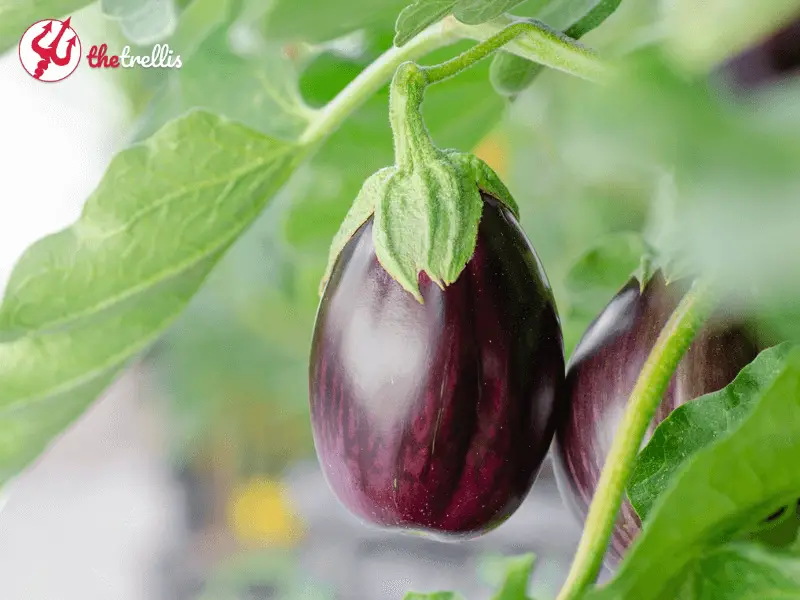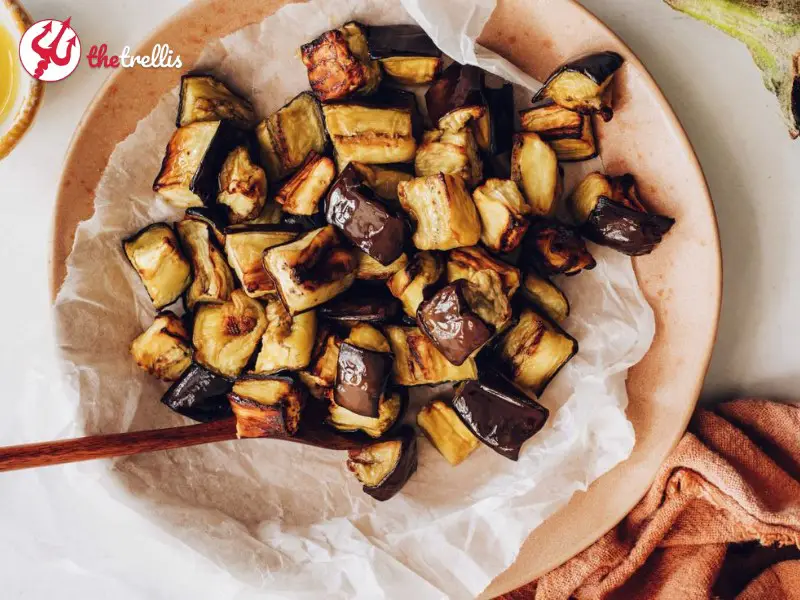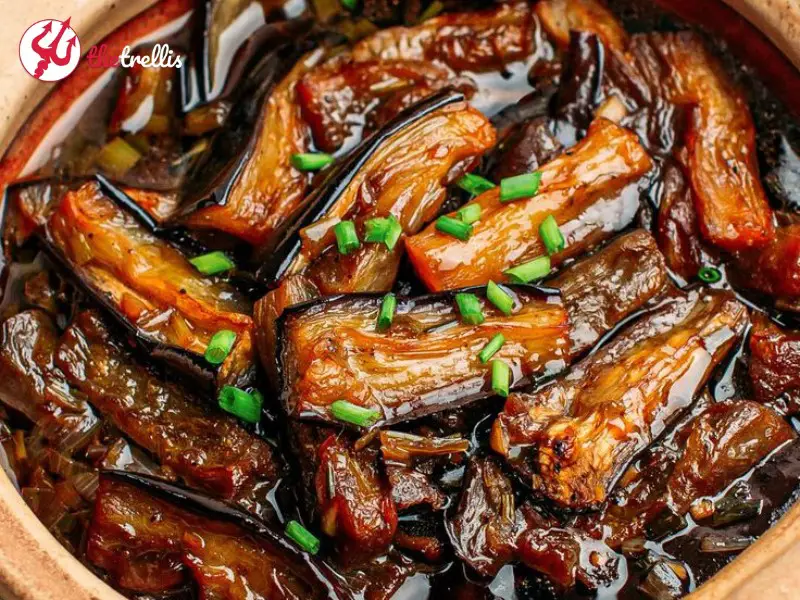
Eggplant, also known as aubergine, is a fascinating crop distinguished by its eye-catching purple color. It ranks as the fifth most economically important member of the Solanaceae family after potato, tomato, pepper, and tobacco. So what does Eggplant taste like? Let’s demystify everything about the taste of this purple vegetable (technically a fruit!), from its raw state to transformed into cooked.
What does Eggplant taste like? Its basic flavor profile
Before diving into cooking methods, let’s explore the answer to the question: What does Eggplant taste like? Its flavor varies significantly between raw and cooked states, making it an incredibly adaptable ingredient for various dishes.
What does raw Eggplant taste like?
Raw Eggplant has a distinct texture and flavor profile that might surprise first-time tasters. It has a spongy, firm texture, similar to a slightly rubbery sponge. The taste is somewhat bland overall with mildly sweet and vegetal (barely-there sweetness), and notable bitter undertones that can be off-putting to many people.
For those wondering, what does raw Eggplant taste like? The answer is a combination of these elements. Honestly, raw Eggplant is not the most appealing. Most people don’t enjoy raw Eggplant because of its dense, foam-like consistency and bitter edge. However, think of it as a blank canvas –this seemingly unremarkable start transforms beautifully with proper cooking.
 What does Eggplant taste like? Compared to cooked Eggplant, raw eggplant is not generally recommended for a slightly bitter taste and a spongy texture.
What does Eggplant taste like? Compared to cooked Eggplant, raw eggplant is not generally recommended for a slightly bitter taste and a spongy texture.
What does cooked Eggplant taste like?
Cooked Eggplant is what makes things more delicious. When you cook Eggplant, it undergoes a remarkable transformation that explains why it’s beloved in cuisines worldwide. Properly cooked Eggplant becomes:
- Rich and meaty in texture, more incredibly tender and creamy, similar to the texture of mashed potatoes
- Mild and sweet, with the bitterness largely dissipated
- Slightly smoky, especially when grilled or roasted
- It absorbs surrounding seasonings you cook it with excellently
 Cooking transforms the eggplant, bringing out rich, savory flavor, and tender and creamy texture, almost melt-in-your-mouth.
Cooking transforms the eggplant, bringing out rich, savory flavor, and tender and creamy texture, almost melt-in-your-mouth.
What do the components of Eggplant taste like?
One of the most interesting aspects of Eggplant is how its different components contribute to its overall taste:
The Skin
- Typically more bitter than the flesh (especially more bitter in older fruits)
- Becomes tender when cooked properly
- Adds a pleasant textural contrast
- Edible but can be tough in mature fruits
- Contains valuable nutrients
The Seeds
- More noticeable in mature Eggplants
- Contribute to the fruit’s overall bitterness
- Generally more numerous and bitter in “female” Eggplants (those with more seeds)
- Become tender and barely noticeable when properly cooked
The Flesh
- The most versatile part
- Acts as a flavor sponge that highly absorbents other flavors
- Changes from firm to silky become creamy and rich when cooked
- Develops rich taste with proper cooking
- Takes on a meaty, earthy, or smoky character depending on the cooking method
Common varieties and their taste differences
Different Eggplant varieties with subtle taste variations affect the truth behind the question “What does Eggplant taste like”:
Globe Eggplant: This is a standard large purple variety. It has a mild taste, more bitter than other varieties. Globe Eggplant is a good all-purpose choice for most cooking methods.
Italian Eggplant: This type has more tender flesh. Its seedless and less bitter properties make it sweeter than the globe variety.
Asian Varieties: The Asian Eggplant variety is characterized by a firmer and crunchy texture, thinner skin, fewer seeds, and less bitter than larger varieties.
How to ensure the best Eggplant taste
Follow these tips to maximize Eggplant’s flavor potential:
The art of selecting the perfect Eggplant
Great taste starts with picking the right Eggplant. The best-tasting Eggplants are found during the summer months (May to August). During this season, the fresh will have optimal texture, more intense flavors, and less bitterness.
Look for these signs of a perfect Eggplant:
- Glossy, avoid wrinkled or dull skin
- Choose fruits that feel heavy for their size
- Pick smaller specimens for fewer seeds, more tender flesh, and less bitterness
- Check for springy flesh by pressing
Proper preparation: Salt treatment (Essential step)
This traditional method is crucial for optimal taste:
- Slice the Eggplant as needed
- Sprinkle generously with salt
- Let sit for 15-20 minutes
- Pat dry before cooking
This process helps improve texture, remove bitter compounds, reduce excess moisture, and particularly enhance flavor absorption.
Best Cooking Methods
The way you cook Eggplant dramatically affects its final taste. Here are the best methods:
- High-Heat Roasting (400°F/200°C): This creates a crispy exterior, makes a creamy interior, reduces bitter notes, and develops sweet caramelized flavors.
- Grilling: This keeps Eggplant intact, creates attractive char marks, adds smoky complexity, and brings out natural sweetness.
- Braising: Eggplant is perfect for absorbing sauces. Braising creates ultra-tender and flavorful texture and develops rich, complex flavors.
 Eggplant can be cooked in various ways – grilled, fried, baked, or even in stews.
Eggplant can be cooked in various ways – grilled, fried, baked, or even in stews.
Alternative cooking methods:
- Plant Milk Soak: Soaking in unsweetened plant milk (works best with almond or cashew milk) for 20-30 minutes creates a creamier texture and reduces bitterness.
- Oil Application: Let’s brush with oil instead of deep frying. This helps to maintain better texture and prevent excessive oil absorption for a less greasy final dish.
Common taste issues and how to avoid them
Even experienced cooks sometimes encounter Eggplant challenges. Here’s how to avoid common taste problems:
Reducing bitterness
- Choose younger, smaller Eggplants
- Remove skin if very bitter
- Use the salt treatment
- Cook thoroughly
Preventing sogginess:
- Cook at high temperatures, avoid undercook
- Don’t overcrowd while cooking
- Watch cooking time, control moisture content
Avoiding greasiness:
- Brush with oil instead of deep frying
- Use high-heat cooking methods
- Don’t overcrowd the pan or space ingredients apart
- Pat dry after salting
Storage tips for optimal taste
Proper storage is crucial for maintaining Eggplant’s best flavor:
- Store in a ventilated and cool area away from direct sunlight
- Avoid refrigeration when possible
- Use within 3-5 days of purchase
- Avoid plastic bags which can trap moisture
Conclusion
Understanding “What does Eggplant taste like” is essential to enjoying this versatile vegetable in the best way. As The Trellis explains, while raw Eggplant might seem uninspiring, cooking transforms it into a delicious ingredient that absorbs flavors beautifully. With proper selection, preparation, and cooking techniques, Eggplant can become a delicious addition to countless dishes.
Learn More About Grilling
If you want to learn more about grilling, check out these other helpful resources!









